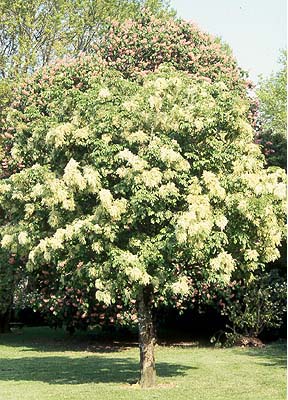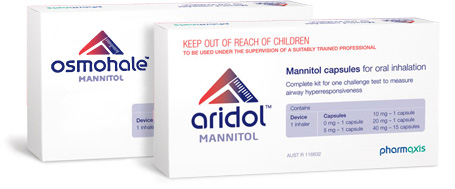Mannitol is a naturally occurring sugar alcohol from the sap of the manna ash tree that can be produced as a dry powder. In the 1990s, Dr Sandra Anderson and colleagues at Sydney's Royal Prince Alfred Hospital (RPAH) began research into how inhaled mannitol can be used to diagnose asthma. This work resulted in the development of two new pharmaceutical products, Aridol® and Bronchitol®.
A landscape format version of this case study is available as a PDF from the Downloads section below.
Origin
Early in the 1990s, Dr Sandra Anderson and colleagues at RPAH began work on testing mannitol in a dry powder form as an alternative to exercise as a stimulus for provoking an episode of asthma (bronchial provocation test). An asthmatic response to a spray-dried preparation of mannitol was found to be a good indicator of currently active asthma, and a new bronchial provocation test was born.
The team also proposed that mannitol had the potential to be used as a treatment to enhance the clearance of mucus from the lungs of patients with asthma, bronchiectasis and cystic fibrosis. A patent was registered in 1995 and the team published a number of key journal articles in 1997.

Mannitol (C6 H14 06, MW 182) is a naturally occurring sugar alcohol found in most vegetables and the sap of the manna ash tree (Fraxinusornus). It resists absorption at high relative humidity, and is a stable substance commonly used as a filler or bulking agent in capsules and tablets.
Grants and Investment
NHMRC
NHMRC supported Dr Anderson and her team with a range of project grants from the 1980s through to 2006. Grants specific to the study of mannitol, from bronchial provocation tests through to developing pharmaceuticals suitable for clinical trial, included:
- Dr Sandra Anderson, RPAH: Project grants, 1991, 1994, 1999 and 2003
- Dr Evangelia Daviskas, RPAH: Project grant, 2005
- Professor Hak-Kim Chan, University of Sydney: Development grant, 2005.
The team also received a number of NHMRC equipment grants during the 1990s.
Other grants and investments
- AusIndustry START grant: 1998-2002
- Asthma Foundation of NSW: 1992-93; 2004
- Australian Respiratory Council: 2002
- Community Health and Tuberculosis Association: 2002
- Ramaciotti grant: 1997
- Private investment from Genentech Inc, USA, and Fisons Pharmaceuticals (which financed the patent).
Commercialisation Journey
Anderson and her colleagues sought out numerous partners on their journey to commercialisation for:
- equipment and medical device development (Fisons Pharmaceuticals, Boehringer Ingelheim)
- product development and investment (Rhone-Poulenc Rorer - later Aventis Pharma; Rothschild Bioscience - now GBS Ventures; Pharmaxis Ltd).
In 1998, Praxis Pharmaceuticals (later Pharmaxis Ltd) was founded in Canberra by Dr Brett Charlton and Dr William Cowden to develop commercial compounds for the treatment of autoimmune diseases. Charlton and Cowden had previously worked at the John Curtin School of Medical Research, at the Australian National University (ANU). Their initial investors provided funding for patents they licensed from ANU, as well as from CSIRO. While these patents did not progress to commercial development, they provided the initial investment and momentum for Pharmaxis to take the mannitol patent through to commercialisation.
In 2001, Pharmaxis licensed patents for respiratory products from the Central Sydney Area Health Service (which included RPAH) and in 2002 they established a production facility in Frenchs Forest, Sydney. In 2003, Pharmaxis was listed on the ASX, and was also granted a manufacturing licence by the Therapeutic Goods Administration (TGA) and production commenced. Pharmaxis funded the clinical trials needed to bring the products to market.
Trials and Results
Clinical tests based on the NHMRC grants began at RPAH in 1994.
Later clinical trials were conducted by Pharmaxis in order to develop mannitol into products for market. Two products were trialled:
- Aridol®: for identifying bronchial hyperresponsiveness to assist in the diagnosis of asthma; and
- Bronchitol®: for the treatment of patients with bronchiectasis and cystic fibrosis (CF) to help them clear mucus from their lungs.
Other significant milestones
- Pharmaxis completed Phase III trials for Aridol® and Phase II trials for Bronchitol® by 2003. In 2005, Phase II trials for Bronchitol® for CF patients were completed
- 2006: Aridol® approved by the TGA
- 2009: Aridol® approved by the European Medicines Agency (EMA); Bronchitol® granted orphan drug status by TGA, US Food and Drug Administration (FDA) and EMA
- 2010: Aridol® approved by the US FDA; Phase III trials for Bronchitol® completed
- 2011: Bronchitol® approved by the TGA
- 2012: Bronchitol® approved for listing on the Pharmaceutical Benefits Scheme (PBS); Bronchitol® approved by the EMA for use in CF in the European Union.
Health Outcomes
Today, two products are now available worldwide as a result of this work. Aridol® (also known as Osmohale®), which uses a dry mannitol powder aerosol as a test to identify asthma and assess its severity; and Bronchitol®, which also uses dry mannitol powder to assist people with cystic fibrosis to clear their airways of mucus. The journey from concept to commercialisation has taken approximately 25 years.


Aridol® and Bronchitol® timeline
| Date | Event |
|---|---|
| 1991 | NHMRC Project Grant |
| 1991 | Research Commences |
| 1994 | NHMRC Project Grant |
| 1995 | Patent Registered |
| 1999 | NHMRC Project Grant |
| 2001 | Pharmaxis licensed the patent |
| 2002 | ARC Grant |
| 2003 | NHMRC Project Grant |
| 2005 | NHMRC Project Grant |
| 2005 | NHMRC Development Grant |
| 2006 | TGA Approval (Aridol) |
| 2009 | EMA Approval (Aridol) |
| 2009 | Orphan Drug Designation (Bronchitol) |
| 2010 | US FDA Approval (Aridol) |
| 2011 | TGA Approval (Bronchitol) |
| 2012 | EMA Approval (Bronchitol in CF) |
| 2012 | PBS Listing (Bronchitol) |
Researcher Profiles
Dr Sandra Anderson AM
Dr Anderson is a world authority on the measurement and management of exercise-induced asthma. Her work with the sugar mannitol led to the development of Aridol® and Bronchitol®. Dr Anderson's career includes Principal Hospital Scientist at RPAH Sydney, 1979 2014; Honorary Consultant, Pharmaxis, Sydney, 2001-14; Clinical Professor in the Sydney Medical School - Central, University of Sydney, 2007 to the present. She has 336 publications, and her research has been funded by NHMRC for over 20 years. In 2012 she was awarded an honorary MD from the University of Uppsala, Sweden, and she became a Member of the Order of Australia.
Professor Hak-Kim Chan
Professor Chan is Professor in Pharmaceutics, Sydney Pharmacy School, and is a world leader in respiratory drug delivery. He played a pivotal role in the development of Aridol® and Bronchitol®. Professor Chan has more than 400 scientific publications on pharmaceutical formulation and drug delivery and holds seven patents in these areas. He is a Fellow of the American Association of Pharmaceutical Scientists, has been a Fellow of the Royal Australian Chemical Institute (RACI), and was Chair of the NSW Pharmaceutical Science Group of the RACI, and Vice President of the Asian Federation for Pharmaceutical Sciences.
Dr Brett Charlton
Dr Charlton is co-founder of Pharmaxis Ltd. and has been its Medical Director since June 1998. He has negotiated licence and research arrangements at the ANU for IP and research facilities. He helped to successfully attract funding from a range of public and private investors to develop Aridol® and Bronchitol®. Dr Charlton was an NHMRC postdoctoral fellow at the Walter and Eliza Hall Institute and visiting clinician at Royal Melbourne Hospital working on diabetes and autoimmunity. He also served as a Founding Medical Director of the National Health Sciences Centre in Canberra, and established the Clinical Trials Unit. In 1995 he was awarded the Aza/Lilly Diabetes Fellowship from Diabetes Australia.
Dr Evangelia Daviskas
Dr Daviskas's career centred around the Department of Respiratory and Sleep Medicine at RPAH, Sydney. Her lifelong interest in physiology led her to join the hospital in 1976, where she worked closely with Dr Anderson for many decades, later becoming a Principal Hospital Scientist. Dr Daviskas has made important contributions to the assessment and treatment of patients with respiratory disorders such as asthma, bronchiectasis and cystic fibrosis. She has published over 50 journal papers and seven book chapters, and has been a recipient of two NHMRC grants. Now retired, Dr Daviskas is an Honorary Affiliate with the Respiratory Technology Group, Woolcock Institute of Medical Research.
Dr John Daniel Brannan
Dr Brannan is the Scientific Director, Department of Respiratory and Sleep Medicine at the John Hunter Hospital, NSW. He is a specialist in bronchial challenge testing for the assessment of asthma and exercise-induced bronchoconstriction. Early in his academic career, he worked with Drs Anderson and Daviskas on some of the emerging studies on the investigation of dry powders for bronchial provocation. He was an integral member of the research team that led the mannitol test to be the first registered bronchial provocation test in Australia. Dr Brannan has published 66 papers in peer reviewed journals and four book chapters. He has been an invited speaker to both national and international meetings.